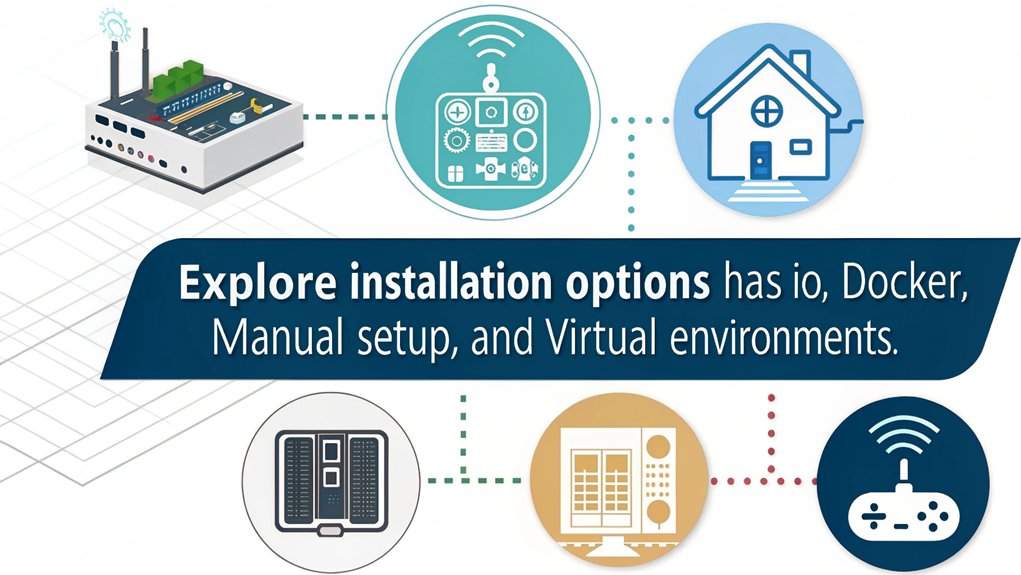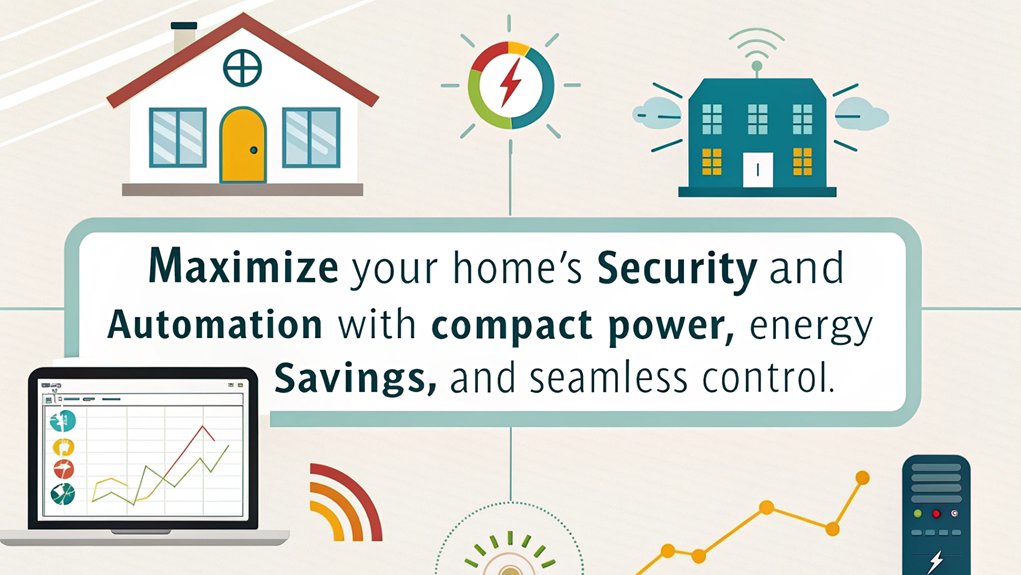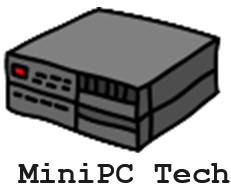To use a mini PC for home automation and security, start by selecting one with a multi-core processor, at least 8GB RAM, and SSD storage for better performance. Install a compatible home assistant software, which lets you manage smart devices seamlessly. This mini PC acts as a hub for advanced automation routines and real-time surveillance management. For security, leverage its processing power to handle video analytics and remote access for efficient monitoring. With low power consumption and compact design, it’s both cost-effective and space-saving. Explore further to discover additional tips and insights on optimizing your setup.
Key Takeaways
- Select a powerful mini PC with multi-core processors and at least 8GB RAM to effectively manage home automation tasks and security surveillance.
- Install compatible home assistant software on the mini PC for unified control and automation of all connected smart devices and IP cameras.
- Utilize multiple connectivity options available on the mini PC, such as USB and Wi-Fi, to integrate various home automation devices seamlessly.
- Implement advanced video surveillance features, including local storage and video analytics, to enhance security measures in your home environment.
- Opt for energy-efficient mini PCs to reduce electricity costs while maintaining reliable 24/7 operation for home automation and security functions.
Choosing the Mini PC For Home Automation and Security: Selection and Setup
When selecting a mini PC for home automation, consider three key criteria: processing power, RAM and storage, and connectivity options.
Start with processing power; choose a mini PC with a multi-core processor, like an Intel Core i5 or i7, or an AMD Ryzen. These will handle automation tasks and device integrations smoothly. For future-proofing, prioritize models with at least 8GB of RAM, although 16GB or more is recommended. Confirm the storage is sufficient for Home Assistant and its databases, ideally a solid-state drive (SSD) of at least 128GB, with support for NVMe for speedy performance. Many mini PCs can serve as home assistants with appropriate software, ensuring optimal performance when hardware meets software specifications. Additionally, selecting a mini PC with low power consumption helps reduce overall energy costs associated with running the system continuously. This also aligns with eco-friendly practices by minimizing the carbon footprint.
Next, look at connectivity options. Multiple USB ports and HDMI are essential, while Ethernet ports provide reliable wired connections. Opt for mini PCs with Wi-Fi 6 or Wi-Fi 6E and Bluetooth 5.2 or higher, facilitating seamless device integration. Ensure the mini PC includes modern ports such as Thunderbolt for enhanced connectivity.
Finally, check for hardware compatibility with the desired home assistant software; it’s vital for effective software integration. Assess the overall energy efficiency through low power consumption models, ideally those with ENERGY STAR certification. This ensures that your setup remains efficient and cost-effective over time.
Installation Methods for Home Assistant

Installing Home Assistant on your mini PC offers several methods, each catering to different needs and levels of expertise.
One approach is the supervised installation, which allows you to run the Supervisor component over an existing operating system. This method provides more control but requires advanced technical skills, especially with the Linux command line. Additionally, it can be beneficial for users looking to utilize advanced features provided by the Supervisor component. Notably, a NUC device with a pre-installed Home Assistant simplifies the process for those less familiar with technical setups. This setup also leverages the energy efficiency of mini PCs, ensuring low utility costs for continuous operation.
If you’re looking for flexibility, consider running Home Assistant within a virtual machine (VM) using software like Proxmox or VirtualBox. This installation method not only enhances security through isolation but also lets you manage multiple VMs and guarantees your setup can easily scale.
Alternatively, you can opt for container installation, which uses Docker or similar technologies. While this method is more lightweight and suitable if you only need core functionalities, it won’t provide the full Supervisor experience or add-ons. This approach is ideal for users preferring a minimal installation with less complexity. It also aligns well with the compact design and portability of mini PCs, making them easy to relocate and set up as needed.
Regardless of the method you choose, confirm your mini PC meets the minimum system requirements for peak performance.
Each method has its unique benefits, so select the one that best aligns with your needs and skill level. Ensuring compatibility with your operating system is crucial for optimal performance, as highlighted by the importance of operating system compatibility in mini PC configurations.
Home Automation Capabilities

Home automation capabilities of a mini PC create a powerful and versatile platform for managing your smart home ecosystem. By acting as a central hub, it allows you to control various smart devices from one interface, which simplifies smart device integration and encourages innovation in your home automation.
Key features include:
- Advanced automation routines: You can program devices to execute tasks automatically, enhancing convenience.
- Multiple connectivity options: USB, Ethernet, HDMI, Wi-Fi, and Bluetooth guarantee compatibility with a wide range of devices.
- Remote control access: Monitor and manage devices from anywhere, giving you real-time control. Connectivity options ensure seamless integration with a variety of smart devices and simplify the communication process. Additionally, employing a mini PC as a dedicated home automation hub will enhance the efficiency of your smart home operations.
With the ability to manage lights, thermostats, and security systems through a unified platform, setting up automation routines becomes second nature. This is further supported by the mini PC’s energy-efficient design, which ensures continuous operation without significant power consumption. The mini PC’s low power consumption aligns with energy efficiency goals, reducing overall electricity bills.
This versatility is further enhanced by support for voice commands and customizable interfaces, enabling you to tailor your home automation experience to fit your lifestyle.
Mini PCs also offer expandable storage and RAM for future upgrades, keeping your system agile as technology evolves.
Embrace the convenience and efficiency of a mini PC for a smart home that adapts to your needs.
Security and Surveillance Options

For effective security and surveillance, mini PCs provide a reliable and powerful solution that integrates seamlessly into your smart home ecosystem. These compact devices utilize industrial-grade components, guaranteeing 24/7 operation and uninterrupted high-quality video processing. With multiple network ports, including dual gigabit LAN, mini PCs assure superior video streaming from your IP cameras. You can connect various security cameras, including Power over Ethernet (PoE) ones, enhancing the scalability of your surveillance setup (statistically significant crime-solving attributed to surveillance footage). By incorporating advanced video analytics, such as person detection and facial recognition, you increase your security effectiveness. Additionally, ensuring secure user authentication through multi-factor authentication (MFA) protects access to your surveillance system. PoE cameras offer high-resolution footage, ensuring that every detail is captured for your records. Local video storage solutions guarantee that you have ample space for keeping surveillance footage accessible. The small form factor of mini PCs allows for covert installation, enabling you to discreetly mount them in tight spaces, behind monitors, or even inside furniture. Their fanless designs contribute to quiet operation, minimizing detection risks. In addition, remote access via mobile apps, combined with stable dual WiFi and gigabit Ethernet support, allows seamless monitoring from anywhere. This innovation in security and surveillance makes mini PCs an ideal choice for guaranteeing your home is secure while maintaining discreet and efficient operation. Moreover, ensuring proper thermal management is crucial to prevent overheating during intensive tasks like continuous video processing.
Performance and Efficiency Benefits

How can mini PCs enhance your home automation experience? With their powerful processing capabilities, mini PCs can effortlessly manage a multitude of smart devices while ensuring multitasking efficiency. Their compact design doesn’t compromise on performance, enabling you to run complex applications, stream media, and even tackle content creation projects. Mini PCs, particularly workstations, are also ideal for handling demanding projects across various industries. Moreover, their versatile connectivity options allow seamless integration with all of your smart devices, ensuring a reliable network at all times. They are also highly cost-effective, making them a budget-friendly option for home automation.
Additionally, many mini PCs come equipped with HDMI 2.1 ports, which are necessary for high-resolution video playback and future-proofing your setup.
Here are three key benefits that demonstrate how mini PCs optimize your home automation system:
- High Processing Power: With Intel or AMD processors, you’ll get the robust performance needed to manage multiple smart devices simultaneously.
- Energy Efficiency: Mini PCs consume much less power than traditional desktops, keeping your electricity bills down while being eco-friendly.
- Space-Saving Design: Their compact size allows for easy placement anywhere in your home, from a clutter-free desk to behind a monitor, making them ideal for small living spaces.
Frequently Asked Questions
Can I Use a Mini PC for Gaming and Home Automation?
Absolutely, you can release the ultimate mini gaming powerhouse while reaping automation benefits! This dual-function device combines powerful performance, multitasking abilities, and seamless integration, letting you game and control your smart home effortlessly.
How Do I Back up Home Assistant Data on a Mini PC?
To back up Home Assistant data on your mini PC, implement robust backup solutions ensuring data integrity. Use the UI or command line for creating, managing, and automating backups for seamless restoration and reliability.
What Operating Systems Can Run on a Mini PC Besides Home Assistant?
“Variety is the spice of life.” You’ve got options! Besides Home Assistant, you can run Linux distributions, explore Windows alternatives, or utilize IoT platforms and open-source solutions on your mini PC for enhanced functionality.
Is Remote Access Possible for My Mini PC Setup?
Yes, remote access is possible for your mini PC setup. By enabling remote desktop and configuring security settings, you can securely connect from anywhere. Just remember to use strong passwords and update your firewall regularly.
How Do I Troubleshoot Connectivity Issues With a Mini PC?
To troubleshoot connectivity issues, check your network configuration for errors, and monitor for Wi-Fi interference. Restart devices, update drivers, and evaluate cables to guarantee peak performance and a stable connection for your mini PC.
Conclusion
Using a mini PC for home automation and security offers a compact yet powerful solution for managing your smart devices. For instance, consider a family that set up a mini PC with Home Assistant to seamlessly control lights, thermostats, and cameras. This streamlined system not only improved energy efficiency but also enhanced their security with real-time surveillance access. By investing in a mini PC, you can create an efficient, centralized hub for all your home automation needs.

I am a retired software engineer with experience in a multitude of areas including managing AWS and VMWare development environments. I bought a relative a mini-PC a year ago and have become passionate about the technology and its potential to change how we deploy software.

